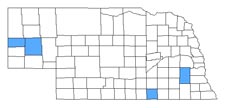
| Cicindela circumpict johnsonii Fitch |
| Adult Length: 13 to 16.5 mm |
| Appearance: The dorsal color of the adults is somewhat variable, but the maculation pattern is consistent. Adults may be blackish, dark reddish brown, red, green, or blue with maculation consisting of a continuous marginal band with small swellings in the posthumeral and subapical areas, and slightly more so in the middle band area. |
| Similar Species: This species could easily be confused with Cicindela togata globicollis, with which it often occurs. Cicindela togata is more of a brassy brown color, and even reddish brown individuals of C. circumpicta are either darker or more reddish in color. Adults of C. circumpicta are also consistently larger than those of C. togata. |
| Biology: This species occurs in saline areas, particularly on moist salty clay soils. Adults and larvae frequent open areas on salt flats as well as along the edges of vegetated areas. The adults are quite skittish and will often fly for over 20 meters when alarmed. |
| Adult Life History: Adults emerge from the pupa mostly in June and early July. This is somewhat variable and in some years emergence may begin as early as late May. Peak numbers normally occur in July with a drop in numbers as the summer progresses. Adults are normally scarce by late August. It is a summer species and may be attracted to lights at night. |
| Larval Life History: Eggs are laid mostly in July. Most larvae reach the second instar by fall before overwintering. The third instar is reached the following summer before a second overwintering period. Pupation occurs in May and June of the next summer. The larval stage lasts two years. Larvae develop in salty clay soils in the open or especially along the edge of vegetation. Burrows are about 10 to 30 cm in depth on average. |
| Biogeography: In Nebraska this species is only known from two counties, Lancaster and Scotts Bluff. Though Carter (1989) reports it from Nuckolls County, it has been suggested it no longer occurs there. A new record for Morrill County was obtained in 2004. In North America this species has a somewhat patchy distribution and occurs from Nebraska to New Mexico and eastern Texas south into northern Mexico. In addition there are isolated populations in eastern North Dakota and central Missouri. There are three described subspecies. |



